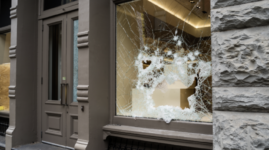Vandalism Offences in Australia

Whether it comes in the form of graffiti or destroying or damaging property, vandalism is common in this day and age, especially in urban areas such as Sydney and other major Australian cities.
But it’s important to be aware that while such behaviour may be associated with young people playing up or acting out, or even trying to express themselves by ‘leaving their mark’ when it comes to graffiti, it can be extremely frustrating, disruptive and costly for business and other property owners, and land the person who engages in the conduct on the wrong side of the law – potentially leading to undesirable consequences, such as a criminal conviction.
And while the penalties for vandalism vary depending on the nature of the alleged conduct, some of these offences carry hefty maximum penalties, including lengthy prison sentences.
Here’s a summary of the laws for vandalism offences in Australia.
What is vandalism?
Vandalism refers to the intentional, reckless or malicious destruction or defacement of public or private property without the owner’s consent.
It can include physically damaging property (the focus of this article), as well as acts of graffiti, illegal tree removal or poisoning and arson.
Vandalism is the most widely reported category of criminal offences in New South Wales, according to the Australian Institute of Criminology.
The offence of Graffiti in New South Wales
Section 4 of the Graffiti Control Act 2008 (NSW) prescribes a maximum penalty of four penalty units, which is currently equivalent to $440, for intentionally marking any premises or property without the consent of the occupier or, where the premises is unoccupied, the person in charge.
The section makes clear that the offence does not apply to the marking of any public footpath or public pavement with chalk, including, but not limited to, marking out a hopscotch or handball court with chalk.
The maximum increases to 12 months in prison and/or a fine of 20 penalty units, or $2,200, where the offence is committed in ‘circumstances of aggravation’ – which means by the use of any ‘graffiti implement’ or in such a manner that the mark is not readily removable by wiping or using water or detergent.
A ‘graffiti implement’ is defined as spray paint, a marker pen, or any implement designed or modified to produce a mark that is not readily removable by wiping or by use of water or detergent.
‘Spray paint’ includes any liquid or other substance that is designed to stain, mark or corrode and to be applied from a spray can, and includes the spray can.
General vandalism laws across Australia
On a more general legal, acts of vandalism are criminalised in Australia under standalone State and Territory criminal offences for property damage.
New South Wales
Under New South Wales criminal law, the offence of intentionally or recklessly destroying or damaging property belonging to someone else and is outlined under section 195 of the Crimes Act 1900.
To establish the offence, the prosecution must prove beyond a reasonable doubt that:
- You destroyed or damaged property,
- The property belonged to another person,
- You intended to cause the destruction or damage or were reckless as to whether your actions would cause the destruction or damage, and
- The owner did not consent to the destruction or damage.
Victoria
Under Victorian criminal law, vandalism is covered by the offence of destroying or damaging property outlined under section 197(1) of the Crimes Act 1958 (VIC).
Queensland
Under Queensland criminal law, vandalism is covered by the offence of wilful damage outlined under section 469 of the Qld Criminal Code.
Australian Capital Territory
Under ACT criminal law, vandalism is covered by the offence of destroying or damaging property as outlined under section 116 of the Crimes Act 1900 (ACT) (if damage is less than $5000) to the offence of damaging property as outlined under section 403 of the ACT Criminal Code (if damage is over $5000).
Tasmania
Under Tasmanian criminal law, vandalism is covered by the offence of destroying or injuring property under section 37 of the Police Offences Act 1935 (Tas)
Northern Territory
Under Northern Territory criminal law, vandalism is covered by the offence of intentionally or recklessly cause damage to property belonging to another person outlined under section 241 of the NT Criminal Code.
South Australia
Under South Australia criminal law, vandalism is covered by the offence of property damage outlined under sections 85 of the Criminal Law Consolidation Act 1935 (SA)
Western Australia
Under Western Australian criminal law, vandalism is covered by the offence of wilfully destroying or damaging property under section 444 of the WA Criminal Code as well as destroying, damaging of defacing property by graffiti under section 5 of the Graffiti Vandalism Act 2016 (WA)
Understanding vandalism laws in Australia
It’s important to understand the various terms which constitute elements of vandalism laws across Australia.
Property
Generally NSW criminal law, “property” includes:
every description of real and personal property; money, valuable securities, debts, and legacies; and all deeds and instruments relating to, or evidencing the title or right to any property, or giving a right to recover or receive any money or goods; and includes not only property originally in the possession or under the control of any person, but also any property into or for which the same may have been converted or exchanged, and everything acquired by such conversion or exchange, whether immediately or otherwise.
However, section 195 of the Act makes clear that “property” for the purposes of the vandalism offence does not include a reference to property that is not of a tangible nature, but does include reference to wild creatures that have been tamed or are ordinarily kept in captivity.
Damaging property
An item does not need to be wholly destroyed in order for the offence to be made out., its enough that it is rendered ‘imperfect or inoperative’: A v The Queen [1978] Crim L Rev 689.
Under NSW criminal law, “damaging property” includes removing, obliterating, defacing or altering the unique identifier of the property. The unique identifier is any numbers, letters or symbols that are marked on or attached to the property as a permanent record so as to enable the property to be distinguished from similar property.
What’s the punishment for vandalism offences in Australia?
Punishment for NSW vandalism offence
The maximum penalty for committing the vandalism offence under NSW criminal law is s 5 years imprisonment in the District Court or 2 years if the case remains in the Local Court.
The maximum penalty increases to 10 years if the damage was caused by fire or explosives.
Punishment for Victorian vandalism
The maximum penalty for committing the vandalism offence under Victorian criminal law is 10 years imprisonment.
Punishment for Queensland vandalism offence
The maximum penalty for committing the vandalism offence under Queensland criminal law depends on the circumstances of the damage itself. The range of penalties is from 7 years imprisonment to life imprisonment.
Punishment for ACT vandalism offence
The maximum penalty for committing the vandalism offences under ACT criminal law are fine of $8,000 or 2 years’ imprisonment, or both if charges under the Crimes Act, or a fine of $160,000 or 10 years’ imprisonment, or both if charged under the Criminal Code.
Punishment for Tasmanian vandalism offence
The maximum penalty for committing the vandalism offence under Tasmanian criminal law is a fine up to $3,460.
Punishment for Northern Territory vandalism offence
The maximum penalty for committing the vandalism offence under NT criminal law is 10 years imprisonment.
Punishment for South Australian vandalism offence
The maximum penalty for committing the vandalism offence under South Australian criminal law is 10 years imprisonment.
Punishment for Western Australian vandalism offence
The maximum penalty for committing the vandalism offence under WA criminal law is 10 years imprisonment if charged under the Criminal Code and a fine of $24,000 or 2 years’ imprisonment if charged under the Graffiti Vandalism Act 2016.
Defences to vandalism offences
Vandalism often takes place at night, without any witnesses, so it can be sometimes be difficult for the prosecution to prove.
To convict someone of this offence, the prosecution needs to be able to prove beyond reasonable doubt that the defendant recklessly or intentionally destroyed or damaged property, and that the property wasn’t theirs.
Nobody can be charged with destroying their own property, so if the prosecution can’t prove that someone else owned the property, they can’t find you guilty.
Formal legal defences to vandalism offences could include self-defence, duress and necessity.
Self-defence is where you believed your actions were necessary to defend yourself or another person, or to prevent the unlawful deprivation of your liberty or that of another person, or to protect your property from being taken, destroyed, damaged or interfered with, or to prevent criminal trespass to your land, or remove a person criminally trespassing, and your conduct was a reasonable response to the circumstances as you perceived them at the time.
Duress is where your conduct arose due to an imminent threat made to you or someone close to you, in circumstances where the threat was continuing and serious enough to justify your actions.
Necessity is where you engaged in your actions to avoid serious, irreversible consequences to you or someone you were bound to protect, you honestly and reasonably believed you or the other person were immediate danger and your actions were a reasonable and proportionate response to the danger.
Going to court?
If you are going to court for a vandalism offence , call Sydney Criminal Lawyers® anytime on (02) 9261 8881 to arrange a free first conference with an experienced criminal defence lawyer, who will take the time to advise you of your options, the best path forward and the costs involved.
We offer fixed fees for most criminal and traffic cases.






